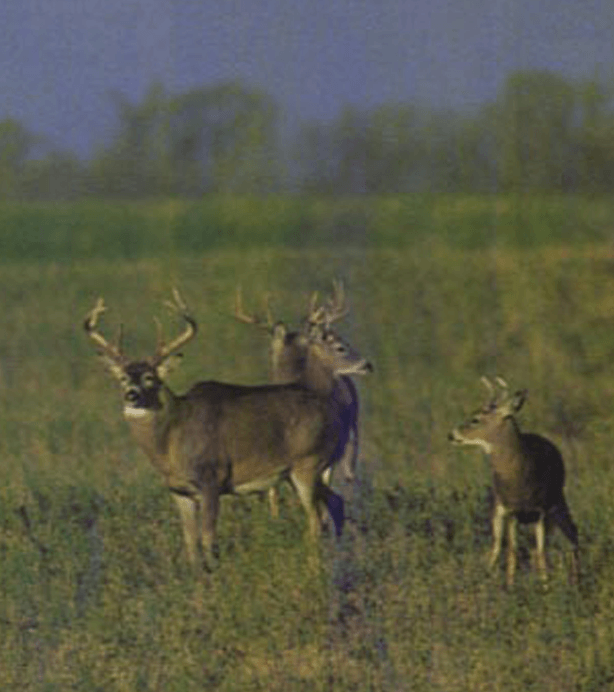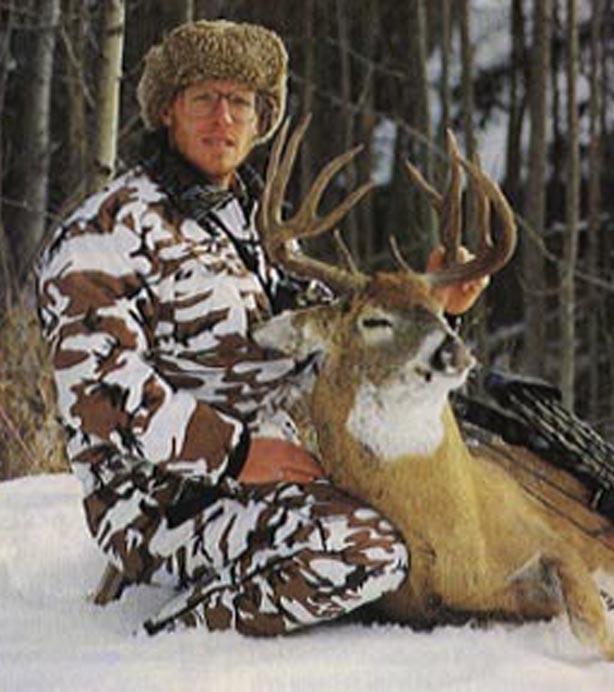In the Zone
by Dwight Schuh, Editor
(Bowhunter Magazine, Nov, 2010)
“Hot on the trail of the doe and fawn, he would follow them straight to our tree. We had him.”
Story and photos by Dwight Schuh, Editor


HOW COULD I NOT be excited? Even Jim sounded excited as he described the big droptine buck.
“He was standing right in the corner, not 75 yards off the intersection of two roads,” Jim said. “Between two houses. That’s a nice buck!”
As a serious bowhunter and a serious all-around guy, Jim Hole is not given to exaggeration. And he knows big whitetails. Jim has hunted and guided in the famed Edmonton Bow Zone, a bowhunting-only buffer of farmland and forest surrounding Edmonton, most of his life. Because of restricted harvest, and because Alberta has the genetics and other ingredients to grow huge bucks, the Bow Zone has a well-deserved reputation for world-class whitetails. Jim personally has killed a buck that gross-measures 198 and nets 192 typical Pope and Young. He and his brother Doug have killed numerous bucks measuring over 150 inches, and his hunters have taken many of similar proportions. So, when Jim got excited over a particular droptine buck, I had no choice but to get excited, too.
On Sunday, November 5, I arrived in Edmonton, where Jim’s friend Leslie Parks met me at the airport. When we arrived at Jim’s lodge, cameraman Brian Rusk, from Wisconsin, was already there. Brian would be videotaping my hunt for Bow-hunter Magazine TV. Also in camp were brothers Rick, Brad, and John Huempfner, who had hunted with Jim for years. The Huempfners live in various parts of the U.S., so when they gather to hunt whitetails, they have a family reunion — and act very much like brothers.
Because of my late arrival, Brian and I decided to sleep in Monday morning, but with the Huempfners acting like brothers — at 5 a.m. — sleeping-in was impossible. Huempf!
After they went hunting and the lodge got quiet, Brian and I organized gear, shot video, and went out about 11 a.m. to a stand on top of an aspen ridge, a beautiful location. The weather was pleasant as we sat in the afternoon sunshine, but as the sun got low and the temperature dropped to 10 degrees F., my feet began to freeze. Next time out I would add chemical footwarmers. About 4:30 p.m., a yearling 6-pointer walked 25 yards from our stand. If he’d been just a few years older…
Upon returning to the lodge, we learned that Rick Huempfner had killed a nice 9-pointer. In celebration that night, the brothers acted very much like brothers. Huempf!
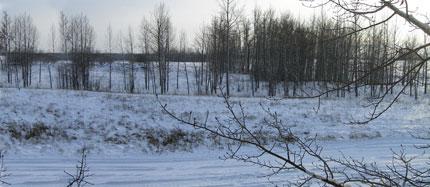
This is where we saw the droptine buck.
ON TUESDAY, BRIAN and I left the lodge at 6 a.m., well before daylight. The plan was for us to hunt proven, established stands, while Jim continued to scout that droptine buck. When he had the buck wired, he would slip in, put up a quick stand, and drop the hammer… Well, that was the plan.
About 7:30 a.m., a doe and fawn came running straight toward us from the east and stopped a few yards from our stand tree. They were straight downwind, but they didn’t seem alarmed. Our de-scenting seemed to be working.
Then we heard grunting and saw a buck coming. Hot on the trail of the doe and fawn, he would follow them straight to our tree. We had him.
I should have known better. The Bow Zone offers no guarantees. Three years before, I had hunted 12 days with my friend Jeff Lander. One afternoon we saw a nontypical buck we estimated in the 220s, and an impressive 10-pointer in the 160s. And a hunter in our motel killed an incredible 8-pointer that measured 164. During my 12 days on stand, however, I never had a mature buck within range.
Jim makes no promises, either. As he points out, hunters in the Bow Zone will spend long, cold hours on stand and will not see a lot of deer. So he promotes his hunt as a quality experience with the potential for a world-class buck — but no guarantees.
With that background in mind, Brian and I were thrilled with this solid 150-inch typical buck walking straight into our trap. I held my bow at the ready; Brian had the camera rolling.
Forty yards out, the buck stopped and then started to circle downwind. He seemed to be watching the doe and fawn below our stands. Was their body language telling him something? We were in a zone, doing everything right. No matter. The buck turned and trotted away. The doe and fawn hung around and then walked away as if nothing had happened.
What went wrong? That situation seemed guaranteed. On the way back to the lodge, Brian and I had just about convinced ourselves these bucks were impossible to kill. Then, opening the door, we heard the brothers. They were celebrating. Brad Huempfner had just killed a nice buck. Huempf again!
THE VERY QUALITY that makes the Bow Zone a world-class whitetail destination is what makes it tough — old deer. Archery-only hunting obviously restricts harvest, and that produces old, big bucks. That’s the attraction. On the downside, old deer are super wary — and tough to kill. Maybe impossible?
The Jim Rules
With more than 100 stand sites established, Jim Hole hunts tactically, placing hunters on transition zones in the mornings, food sources in the evenings. Taking only six hunters per week, he can move individuals around to hunt fresh stands and take advantage of prevailing winds.
In most cases, he does not let hunters walk to stands; he drives them in with a Kawasaki Mule. To minimize disturbance, he does not allow clients to scout or walk around. His goal is to ensure that deer continue to move in natural, unforced patterns.
He’s fanatical about eliminating noise. He hockey-tapes all stands, bow holders, game calls — anything that could tap, click, or produce a foreign sound. He inspects all hunters’ packs, and any that will rustle or crinkle he quarantines from the field.
He insists that hunters hang all hunting clothes outside, where they can air out. He sprays boots with scent eliminator. He won’t let hunters use flashlights to get into and out of stands. Snow on the ground provides adequate visibility.
He insists that hunters organize all gear at the lodge for maximum efficiency. Once they get on stand, no one should be rustling around, trying to organize stuff. He discourages hunters from taking snacks and drinks into the field. “You can eat and drink in the lodge,” he says.
Perhaps most importantly, his stands employ a quick, quiet pin-mount system. The hunter hangs the stand platform on his belt, climbs the tree, slips the stand onto the pin, and climbs aboard to hunt. Slick. All stands are taped for maximum silence.
The nature of the area adds to the difficulty. Edmonton might seem remote, but with a metro-area population of more than one million, it is the largest city in the North, and many people live throughout the farmlands. In short, the deer live among people 12 months a year. They know how to survive.
To top it off, the northern woods are deathly quiet. On stand in the Lower 48, you can always hear crows, tractors, road noise, chainsaws, wind — some kind of background noise. The northern woods are as cold as a morgue and equally quiet, and the most subtle movement — turning your head, lifting your binoculars — seems to explode like a roadside bomb. You feel almost paralyzed, afraid to move.
Jim’s stealthy approach includes pin-mount stands that are taped for absolute silence. I used a climbing belt for safety when climbing trees and placing stands.
For these reasons, Jim makes stiff demands on his hunters (see “The Jim Rules”), not only to give each hunter the best possible chance at a world-class buck, but also to ensure that hunters during following weeks are assured fresh, unpolluted stands. Jim’s rules emphasize caution, stealth, and focus. They demand that — as athletes often say — hunters stay in the zone.
In this sense, hunting with Jim Hole’s Classic Outfitters goes beyond the chance to take a huge whitetail. It’s a boot camp in whitetail tactics that will serve any bowhunter well anywhere in North America. Whether I would kill a deer remained to be seen, but at the very least, Jim had me in the zone, and I would be a better hunter for it.

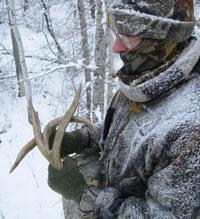
In the deathly silence of the northern woods, sound carries for long distances, which makes rattling and calling effective when rutting bucks are on the prowl.
BY WEDNESDAY, WE STILL had no solid intelligence on the droptine buck, so we continued to hunt perimeter locations to avoid bumping him. That bitter Wednesday morning, we put stands in an aspen grove isolated in the middle of a field where bucks often cornered hot does. The wind was steady in the right direction, and for once it was blowing hard enough to give us good sound cover. We saw some deer in the distance, but none came into our grove.
That afternoon, Jim put us in a group of spruce trees, 20 yards from a fence-corner gate. Numerous deer tracks in the snow there, and scrapes under the spruce branches, gave us confidence.
Late in the afternoon, as a doe coming from the west headed straight to the gate, we got ready and waited quietly. Suddenly she turned and ran across a field — with a big buck sprinting close behind. What had happened? This seemed like a guaranteed scenario. Had we lost focus? Dropped out of the zone? These bucks were impossible.
Just before dark, as we sat pondering our futility, we saw a lone buck on the prowl and another buck trailing a doe. They were all heading east, seemingly toward the same destination.
After our close call in the fence-corner spruce stand, we decided to try there again Thursday afternoon. We climbed into the stand at 2 p.m. and stayed until dark. No deer came close, but we did witness a mini-parade of does north of us, all heading east — toward the same destination as those deer the night before. Hmmmm.
While we were on stand, Jim had been out snooping around, and he had found a field of weeds absolutely pounded by deer. Not so incidentally, all the deer Brian and I had observed were headed toward this very field. And this was very close to where Jim had originally seen the droptine buck. Hmmmm, indeed.
THUS IT WAS THAT on Friday afternoon, Brian and I put our stands at the edge of the weed field. The wind was out of the southeast, perfect for this field. Everything seemed ideal. Then, at 4:30, right when we expected to start seeing deer, a guy came racing by our stand on a three-wheeler, pulling his kids on a sled. Pretty soon he came racing back. Impossible!
That pretty well sealed our fate for the evening, so at 5:30, last shooting light, we were eager to leave. As Brian packed his camera gear, I started climbing down and was just about to hit the ground when Brian whispered, “Don’t move!” A buck came walking along the edge of the field, 30 yards from us, sniffing the ground and grunting. In the twilight we could not see him well, but we could tell one thing — he was big.
Would we ever pull this off? Jim had nailed the spot, and we had stayed in the zone. That buck never knew we were there, even with me hanging on the side of the tree. These bucks were just too smart. They were impossible to kill, something we firmly believed — until we returned to the lodge and learned that John Huempfner had arrowed a beautiful buck that afternoon. The brothers were now three for three. Let the celebration begin. Triple Huempf!
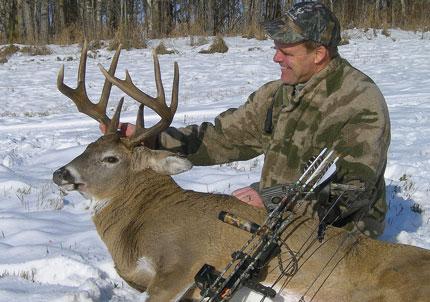 Rick Huempfner took this beauty on Monday, the first day of the hunt period.
Rick Huempfner took this beauty on Monday, the first day of the hunt period.
THE WEED FIELD WAS NOT a good morning stand, so we had Jim put us in a place where we could do some rattling and calling Saturday morning. It was a great-looking spot where the sound would carry well out over a river bottom. The temperature was 10 degrees and the woods were dead calm, perfect for calling, and we gave it a good effort. But we saw no deer.
And, really, our focus was elsewhere. We knew a big buck prowled that weed field, and we wanted another crack at him. So immediately after lunch, we climbed into our stands there. Jim had asked the neighbor not to take his kids sledding right by our stand. We were set.
During the afternoon, the temperature rose to 24 degrees, and we actually got hot for a while. But then the air dutifully cooled with the setting sun, and soon I was beginning to shiver in the eight-degree air.
At 5 p.m., a doe came out of the woods to the east, and then another came running from the south. Then two more does and a small buck, a 6-pointer, headed in from the south. Deer were coming from all sides. But there were no big bucks, and at 5:30, we knew we were finished. The hunt was over.

Brad Huempfner followed up with a fine buck of his own on the second day.
Just as we started packing up, we made out two bucks coming from the south. One was small; the other was not. They entered the field at 5:40, mere shadows against the snow. Coming closer, they became more distinct, and with binoculars I could make out detail. The smaller of the two walked directly under our stands. He was a 6-pointer. The bigger walked down the field edge, 25 yards out. As he stopped broadside, silhouetted against the snow, I could clearly see two droptines hanging off his main beams.
Oh, we’d come close. Maybe this actually was possible. I don’t know. But I do know two things: A big droptine buck still roams the Bow Zone, and after a week with Jim Hole, I’m firmly trained in the zone. In November 2007, I’m going back, and impossible will be nothing. Huempf!
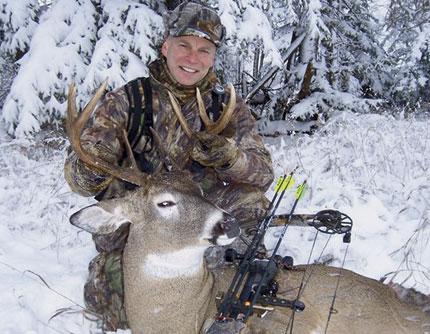
John Huempfner completed the brothers’ triple slam later in the week.
Editor’s Note: To hunt giant whitetails of the Bow Zone, and to get in the whitetail zone, contact: Jim Hole, Jr., Classic Outfitters Ltd.
